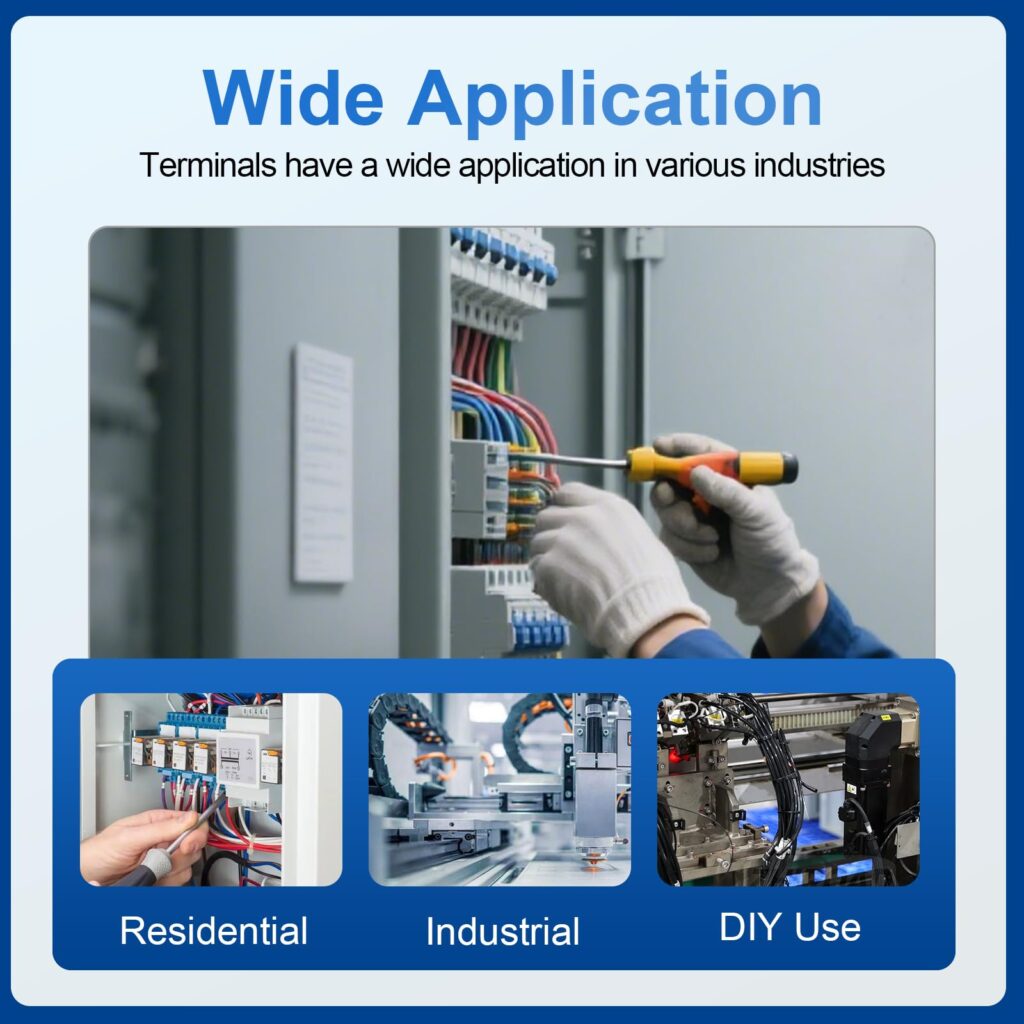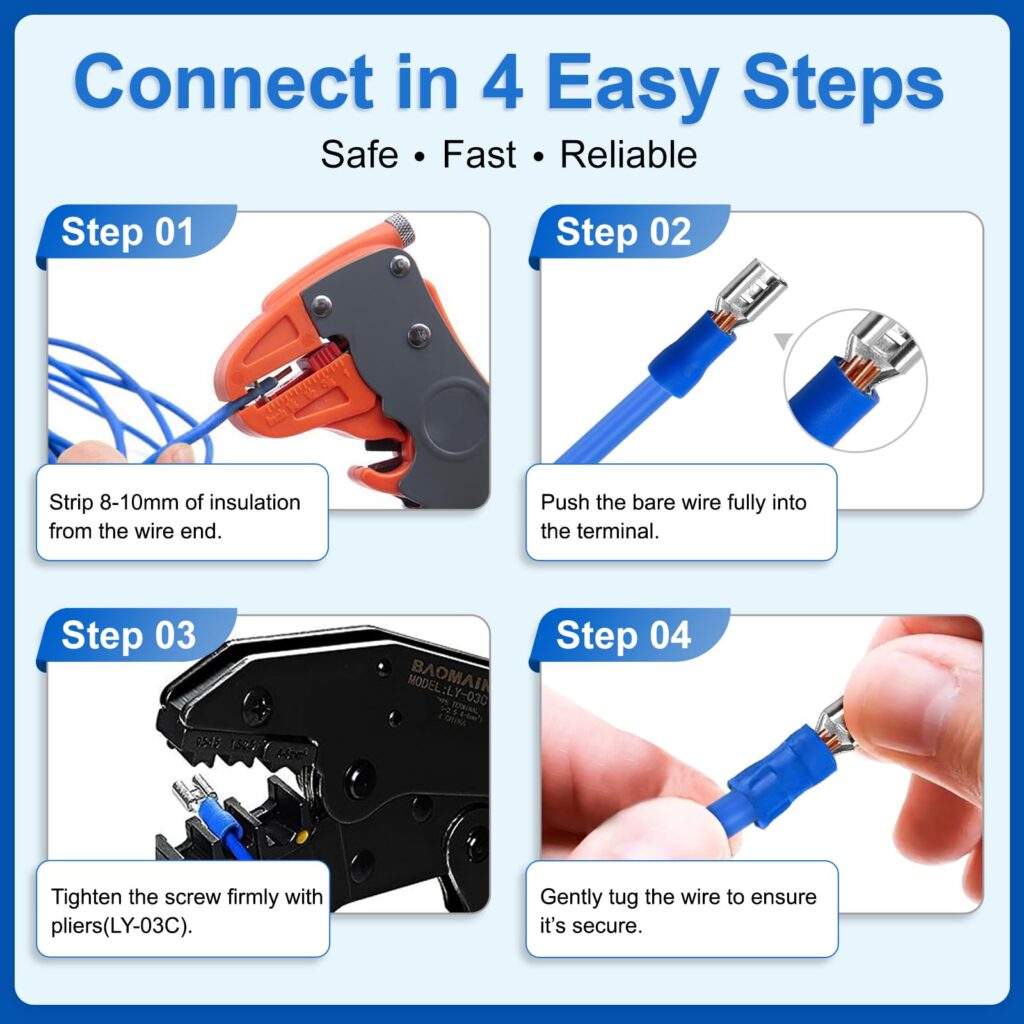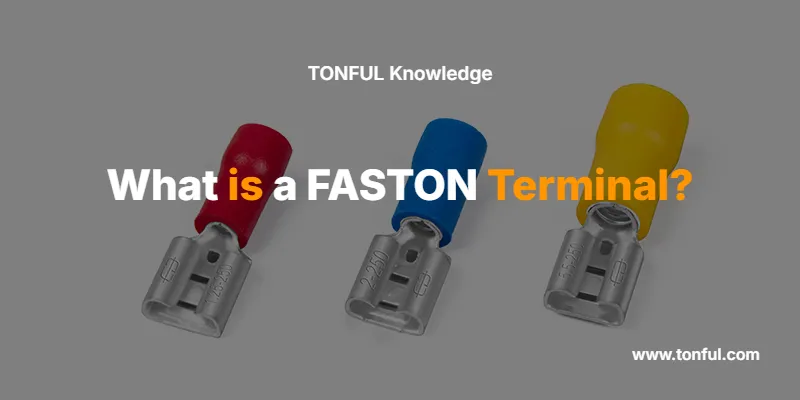A FASTON terminal is a quick-connect electrical connector that creates secure, removable connections without tools. These blade-style connectors feature a flat metal tab that slides into a matching receptacle, providing reliable electrical contact for automotive, appliance, and industrial applications. FASTON terminals eliminate the need for screws or soldering while maintaining excellent conductivity and connection strength.
Understanding FASTON terminals is essential for anyone working with electrical systems, as they’re the industry standard for removable connections in everything from car wiring to household appliances.
What Does FASTON Stand For?

FASTON is a trademarked name from TE Connectivity (formerly AMP) that stands for “FAST-ON” – referring to the quick connection capability. The term has become genericized in the electrical industry, similar to how “Kleenex” represents facial tissues. Other manufacturers produce similar quick-connect terminals using names like “quick-disconnect,” “blade terminal,” or “tab connector.”
Key Characteristics of FASTON Terminals
Physical Design Features
Male Terminal (Tab):
- Flat metal blade with tapered edges for easy insertion
- Standard thickness of 0.020″ (0.5mm) or 0.032″ (0.8mm)
- Crimp barrel for wire attachment
- Available in straight, right-angle, and flag configurations
Female Terminal (Receptacle):
- Spring-loaded housing that grips the male blade
- Dual contact points for reliable electrical connection
- Insulated or non-insulated housing options
- Locking or standard retention mechanisms
Electrical Specifications
| Specification | Range |
|---|---|
| Current Rating | 5A to 60A |
| Voltage Rating | Up to 600V |
| Temperature Range | -40°F to 250°F (-40°C to 121°C) |
| Wire Gauge Capacity | 24 AWG to 10 AWG |
| Contact Resistance | <5 milliohms |
Types of FASTON Terminals
By Connection Method
1. Crimp-On Terminals
- Most common type requiring crimping tools
- Available for various wire gauges
- Permanent wire attachment
- Color-coded by wire size
2. Solder-Type Terminals
- Wire attachment via soldering
- Higher reliability for critical applications
- Requires more installation time
- Better for vibration-prone environments
3. Screw-Type Terminals
- Wire secured with set screw
- Reusable connection method
- Ideal for temporary installations
- Higher profile than crimp versions
By Width Classification
| Width | Common Applications | Current Rating |
|---|---|---|
| 0.110″ (2.8mm) | Low-current electronics, automotive accessories | 5-15A |
| 0.187″ (4.75mm) | Automotive, small appliances | 15-25A |
| 0.250″ (6.35mm) | Home appliances, HVAC systems | 20-35A |
| 0.375″ (9.5mm) | Industrial equipment, heavy-duty automotive | 35-60A |
By Mounting Style
Straight Terminals
- Standard inline connection
- Most compact profile
- Used in tight spaces
Right-Angle Terminals
- 90-degree wire exit
- Reduces bending stress on wires
- Common in panel-mount applications
Flag Terminals
- Wide mounting surface
- Enhanced pullout resistance
- Used for high-vibration environments
Applications and Use Cases

Automotive Industry
FASTON terminals are extensively used in:
- Fuse blocks and relay connections
- Headlight and taillight assemblies
- Ignition switch connections
- Horn and accessory wiring
- Battery disconnect switches
Why automotive uses FASTON: Quick service access, vibration resistance, and standardized sizes across manufacturers.
Home Appliances
Common appliance applications include:
- Washing machine water valve connections
- Dryer heating element terminals
- Dishwasher pump connections
- Air conditioner compressor wiring
- Refrigerator defrost heater connections
Safety Note: Always disconnect power before working on appliance connections. Many appliances use 240V circuits that can cause serious injury.
HVAC Systems
FASTON terminals connect:
- Thermostat control circuits
- Blower motor connections
- Zone control dampers
- Safety switch circuits
- Transformer secondary connections
Industrial Equipment
Used for:
- Control panel connections
- Motor starter circuits
- Safety interlock systems
- Sensor and switch connections
- PLC input/output modules
Advantages of FASTON Terminals
Operational Benefits
Quick Installation and Removal
- No tools required for connection/disconnection
- Reduces service time by up to 75%
- Allows for easy troubleshooting access
Reliable Electrical Connection
- Multiple contact points ensure consistent conductivity
- Self-cleaning action during connection
- Low contact resistance over time
Vibration Resistance
- Spring-loaded female terminals maintain contact pressure
- Locking versions provide additional security
- Proven performance in high-vibration environments
Cost Benefits
Reduced Labor Costs
- Faster installation than screw terminals
- No special tools required for basic connections
- Simplified training requirements
Inventory Efficiency
- Standardized sizes across applications
- Interchangeable between manufacturers
- Reduced variety of connection hardware needed
How to Select the Right FASTON Terminal
Step 1: Determine Current Requirements
Calculate the maximum current your circuit will carry:
- Continuous current: Normal operating load
- Peak current: Startup or surge conditions
- Safety factor: Select terminal rated 25% above peak current
Step 2: Choose Appropriate Width
| Circuit Current | Recommended Width |
|---|---|
| Up to 10A | 0.110″ (2.8mm) |
| 10-20A | 0.187″ (4.75mm) |
| 20-30A | 0.250″ (6.35mm) |
| 30A+ | 0.375″ (9.5mm) |
Step 3: Select Wire Gauge Compatibility
Match terminal crimp range to your wire gauge:
- Red terminals: 22-18 AWG
- Blue terminals: 16-14 AWG
- Yellow terminals: 12-10 AWG
Step 4: Consider Environmental Factors
High-Temperature Applications:
- Use terminals rated for 250°F (121°C)
- Consider ceramic-filled nylon insulators
- Verify wire insulation temperature rating
High-Vibration Environments:
- Choose locking-style terminals
- Use flag terminals for better retention
- Consider cable strain relief
Outdoor/Corrosive Environments:
- Select tinned copper terminals
- Use fully insulated versions
- Apply dielectric grease to connections
Installation Best Practices
Proper Crimping Technique
Tools Required:
- Ratcheting crimp tool for consistent pressure
- Wire strippers rated for your wire gauge
- Heat shrink tubing (optional)
Step-by-Step Process:
- Strip wire to proper length (typically 1/4″ for most terminals)
- Insert wire fully into crimp barrel – no copper should be visible
- Position crimp tool properly – center on crimp barrel
- Apply full crimping pressure – ratcheting tools prevent incomplete crimps
- Verify connection – gently tug wire to ensure secure attachment
Expert Tip: A properly crimped connection is actually stronger than the wire itself and should never pull out under normal conditions.
Connection Safety Guidelines
Before Making Connections:
- Verify power is off using appropriate voltage tester
- Check terminal compatibility with mating connector
- Inspect terminals for damage or corrosion
During Installation:
- Ensure full insertion of male terminal into female receptacle
- Listen for audible “click” on locking terminals
- Verify connection is secure with gentle tug test
After Connection:
- Apply dielectric grease in corrosive environments
- Use heat shrink or electrical tape on exposed connections
- Label circuits according to local codes
Common Problems and Troubleshooting
Connection Issues
Problem: Loose or Intermittent Connection
- Cause: Worn female terminal springs
- Solution: Replace female terminal or use locking-style connector
Problem: High Resistance/Heat Generation
- Cause: Corrosion or poor crimp connection
- Solution: Clean contacts, re-crimp connection, apply dielectric grease
Problem: Terminal Won’t Stay Connected
- Cause: Damaged retention mechanism
- Solution: Replace terminal or upgrade to locking version
Installation Problems
Problem: Wire Pulls Out of Terminal
- Cause: Insufficient crimp pressure or wrong terminal size
- Solution: Use proper crimp tool, verify wire gauge compatibility
Problem: Terminal Doesn’t Fit Mating Connector
- Cause: Wrong terminal width or damaged blade
- Solution: Verify terminal dimensions, replace if damaged
Safety Considerations and Code Compliance
Electrical Codes and Standards
National Electrical Code (NEC) Requirements:
- Terminals must be listed by recognized testing laboratory
- Wire termination must match terminal specifications
- Proper wire fill in terminal crimp barrel required
- UL 486A covers wire connectors and soldering lugs
- UL 486B covers wire nuts and similar connectors
- Terminals must maintain ratings in intended application
Safety Best Practices
Personal Safety:
- Always verify power is off before working on connections
- Use lockout/tagout procedures in industrial settings
- Wear appropriate PPE including safety glasses
Fire Prevention:
- Don’t exceed terminal current ratings
- Ensure proper crimp connections to prevent overheating
- Use appropriate wire gauge for circuit current
Code Compliance:
- Follow local electrical codes for terminal applications
- Use only listed terminals for permanent installations
- Maintain proper spacing in electrical panels
FASTON vs. Other Connection Types
FASTON vs. Screw Terminals
| Feature | FASTON | Screw Terminal |
|---|---|---|
| Installation Speed | Very Fast | Slow |
| Tool Requirements | None (for connection) | Screwdriver |
| Vibration Resistance | Excellent | Good |
| Current Capacity | Up to 60A | Up to 100A+ |
| Reusability | Excellent | Good |
| Cost | Low | Medium |
FASTON vs. Wire Nuts
| Feature | FASTON | Wire Nuts |
|---|---|---|
| Removability | Excellent | Fair |
| Reliability | Excellent | Good |
| Inspection Ease | Easy | Difficult |
| Vibration Resistance | Excellent | Poor |
| Space Requirements | Compact | Bulky |
| Code Acceptance | Limited | Universal |
FASTON vs. Solder Connections
| Feature | FASTON | Solder |
|---|---|---|
| Installation Time | Seconds | Minutes |
| Skill Required | Low | High |
| Removability | Excellent | Poor |
| Reliability | Excellent | Excellent |
| Cost | Low | Medium |
| Heat Resistance | Good | Excellent |
Expert Tips for Professional Results
Selection Tips
Choose Quality Terminals
- Specify brand-name terminals for critical applications
- Verify UL listing for permanent installations
- Consider plating options (tin, gold) for harsh environments
Size for Safety
- Always round up when between standard sizes
- Consider voltage drop in long wire runs
- Factor in ambient temperature derating
Installation Tips

Proper Tool Selection
- Use ratcheting crimp tools for consistent results
- Replace crimp tool jaws when worn
- Calibrate tools periodically for critical applications
Professional Finishing
- Use heat shrink tubing on high-vibration connections
- Label connections for future service
- Document terminal types and ratings for maintenance records
Frequently Asked Questions
What’s the difference between FASTON and quick-disconnect terminals?
FASTON is a specific brand name from TE Connectivity, while “quick-disconnect” is a generic term for the same type of connector. They function identically, but FASTON terminals often have tighter tolerances and better quality control.
Can I reuse FASTON terminals?
Yes, the connection portion (male/female interface) can be connected and disconnected thousands of times. However, the wire crimp connection is permanent and cannot be reused if the wire is cut.
What size FASTON terminal do I need for 12V automotive applications?
For most 12V automotive accessories drawing under 15 amps, use 0.187″ (4.75mm) width terminals. For higher current applications like electric fans or winches, use 0.250″ (6.35mm) terminals.
Are FASTON terminals waterproof?
Standard FASTON terminals are not waterproof. For outdoor or wet applications, use fully insulated terminals with sealing boots or marine-grade connectors with gaskets.
Can I use automotive FASTON terminals in house wiring?
FASTON terminals are generally not accepted by electrical codes for permanent house wiring installations. They’re typically limited to appliance internal connections and low-voltage applications.
How do I remove a stuck FASTON terminal?
Use needle-nose pliers to grip the insulated portion and pull straight out. For severely stuck terminals, gently rock side-to-side while pulling. Never pull on the wire itself.
What’s the maximum voltage for FASTON terminals?
Standard FASTON terminals are rated up to 600V, but most common applications are 12V automotive or 120/240V appliance circuits. Always verify voltage rating for your specific application.
Do I need special crimping tools for FASTON terminals?
While you can use generic crimp tools, ratcheting crimp tools designed for insulated terminals provide the most consistent and reliable connections. The investment pays off in connection reliability.
Conclusion
FASTON terminals represent the gold standard for quick-connect electrical connections, offering the perfect balance of reliability, convenience, and cost-effectiveness. Their widespread adoption across automotive, appliance, and industrial applications demonstrates their proven performance in demanding environments.
Key takeaways for successful FASTON terminal use:
- Select proper size based on current requirements and wire gauge
- Use quality crimp tools for reliable wire connections
- Follow safety procedures including power-off verification
- Consider environmental factors when choosing terminal specifications
- Maintain connections through periodic inspection and cleaning
Whether you’re a professional electrician, automotive technician, or DIY enthusiast, mastering FASTON terminal selection and installation will improve your electrical connections while reducing service time and increasing reliability.
For complex electrical installations or high-voltage applications, always consult with a licensed electrician to ensure code compliance and safety.

